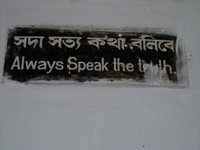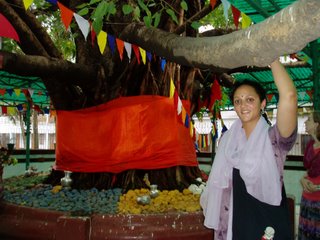Outings and Such



three signs outside the monastery school. timeless wisdom
 sri sri atisa dipankara of vajrayogini, bengal
sri sri atisa dipankara of vajrayogini, bengal
me and the large bodhi tree at the monastery
Tuesday, July 18, 2006
Outings and Such When the student mutiny of week three was in full swing I suggested instead of thrusting all complaints onto the director of the program, let us think things out and get them down on paper in an organized fashion. We made curriculum suggestions, and also suggestions for enhansing the program culturally. How can you learn to speak Bangla if you experience next to nothing about the culture? We have had a few haphazard outings thus far. One was to Dhakeshwari Mandir, which is detailed in a previous blog entry. We also made a trip to the Dharmarajikha Buddhist Monastery. I have taken some photos and will post them when I get the chance. Actually, there was no one to explain anything, and just like the trip to the Mandir, all the teachers that accompany us are all Muslim. None of them have even visited these sites before. I did not want to take the helm, and just start lecturing about this and that. I am a student here. I figured if anyone asked me any direct questions then I would do my best to answer. The lineage of this, the largest existing Buddhist temple in Dhaka, is Theravadan. The old lineage of Bengal is Vajrayana/Sahajiya. This is perhaps extinct in Bengal now. The Theravadan lineages are from direct influence from Burma, the Buddhist country next door. The monastery here is very large, as are the grounds. Even larger is the 900-boy orphanage that the monastery opperates. The main prayer room is very humble, housing a couple bronze Buddha statues donated by Thailand and Burma. In the corner is an older black stone, I think basalt, carving from an old Buddhist site of Bengal. Interesting, the remain of Atisa Dipankara, one of the great Buddhist masters of Bengal and Tibet and the founder of the Kadampa Lineage of Tibetan Buddhism, have recently been returned to Bangladesh, and rest at this site. I suppose one of the irritating things for me about these outings is that this group of wide-eyed young Americans, is very American and slightly ignorant of what they shoud do in different public places and how to carry themselves. I only have to look back at myself five to ten years ago to remember how oblivious I was too. That's how I know. The head monk who came to greet us was speaking only in Bangla, and the teachers had no thought to translate little by little for the benefit of the group. They were asking direct questions, challenging at that, about why Buddhist's don't believe in God or in heaven and afterlife. They were asking these question because they are Muslim and don't have similar concepts in their formal, exoteric religious practices. This would have been an amazing conversation to hear, which I got part maybe about 70 percent. I seemed the head monk was accustomed to answering questions like this. As I exited the prayer room, about six of the students were sitting on a white tiled structure, gawking at monks and orphan kids taking a bath in the massive pond at the center of the monastery complex. If the gawking wasn't bad enough, the head monks comes over and rather calmly requests them sit elsewhere, as they were perched on the top of Atisa's grave. I felt my ancestors shudder. The highlight of our visit was an unsuspecting fence and yard at the side of the complex. Inside rested an incredible Bodhi tree, that had to be at least 350 years old. Pictures soon to follow. This massive, peaceful fellow shared stories of what was here before, and how that had been a monastery site for a long time. Aside form Atisa'a remains, this place resonated the most on the entire propety. They also told us how in the liberation was of 1971, many people sought refuge here and many people were saved. They are staying true to the Buddhist sentiment of compassion in the present day too, by operating a large school, hospital, monks education, and huge orphanage. I find it also very intersting that in the program they are trying to show us the pluralism of Bangladesh. What I am finding on my own, is that Bangladesh is even more pluralistic that it seems when you dig just a little below the surface. This comming weekend we are scheduled to visit the ancient Buddhist sites in the countryside of Bangladesh. I am very excited and am ready to dig a little deeper there too....... Four Winds, Kurukulla aka Yoli aka France |

0 Comments:
Post a Comment
<< Home